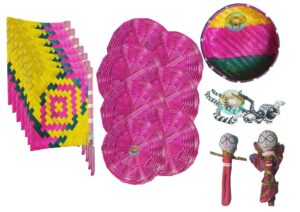Chhatihar:
On the sixth day of birth. Shashthika (Sathi) Bhagwati is worshiped in the evening on a special alpana. The mother and child wear new yellow clothes.Things required are: Purhar Patil, Deep, Earthen pot, Fan made of bamboo (beeain), Kajrauta, Shahi Kant, Knife, Chura, lava, paper, red ink.
Namkaran:
On the 11th or 12th day of the birth of the child or any auspicious day. Pooja of Panch Devata, Vishnu, Navagraha and Parthiv Shivaling is performed. A suitable name often determined by Rashi of the child is then given to the child. The mother, child and the person performing the pooja and rites wear new clothes. At times, the name is written on the lips of the child with durba stem dipped in madhu. This rite is less prevalent.
Annaprashan:
In the 6/8 month for male and 7/9 month for female child. On an auspicious day and time (Shubha Muhurta). After performing puja, the child, in new clothes, is fed payas, sweets by an elderly lady.
Mundan/ Karnvedha:
In 1/3/5 year. Auspicious day and time (see calendar). The hair of the child is cut with scissors and are collected in the anchar of an elderly lady who sits behind the child. This is disposed off in the evening in the roots of bamboo tree or in a river. Durbakshat and chumaon are performed. Feast is held or sweets distributed among the guests.
If Karnvedha (optional) is performed, then ears of the child are pierced with gold earrings (Kundal). This rite can also be performed in Upnayan, where this is an essential rite.
Akshararambha:
In 3rd or 5th year (generally on Mundan Day). In the morning hour, (after Mundan Ceremony) the acharya performs puja of Panch Devata, Kul Devata, Ganesh, Lakshmi, Saraswati, Vishnu, Mahadeva and Brahma. On a whole banana leaf, placed over an alpana, 5 kg of rice is spread. Acharya takes the child in his lap and holding a chalk in the child’s hand writes “OM NAMAH SHIDHDHAM” on rice. It is, then, covered with an yellow cloth. The rice is removed in the evening and used. Nowadays, Akshararambh is also performed on Basant Panchmi day.
Upnayan:
Upanayan is a ceremony in which a young student is taught the importance of the quest for knowledge. The boy learns to worship the sun as the eternal truth of the world, and as the life source of all living beings. He prays to the sun to make his faculties sharp and lustrous. Gayatri, the chant taught to a boy at the Upanayan is a prayer to the source of all truth and transcendental light.
It consists of the following rites:
Udyog, Mati-Mangal, Marab-Thathi, Charakh-katti, Kumram, Matrika Puja, Abhyudayik Shraddha, Churakaran, Upnayan, Vedarambh, Samabartan, Ratim. The celebration ends with Satyanarayan Pooja.
Vivah:
Marriage, according to the Hindu view, is a union of two people based on seven principles: their surrender to each other; common ambitions; mutual respect; responsibility; closeness; trust; joy and performance. All the rituals of this sacrament signify these seven aims.
Consists of following rites:
Sidhdhant, Kumram, Laba-bhujai, Agya-pan, Matrika Pooja and Abhyudayik Shradhdha,Reception of Bariati, Pair-dhoai, Parichain, Kanyadaan, Bibah, Sindur daan, Chaturthi, Dwiraagman.
Produced by MithilanchalGroup


Comments
I think this is a real great blog post.Really looking forward to read more. Fantastic.
Thanks for the post.Much thanks again. Keep writing.